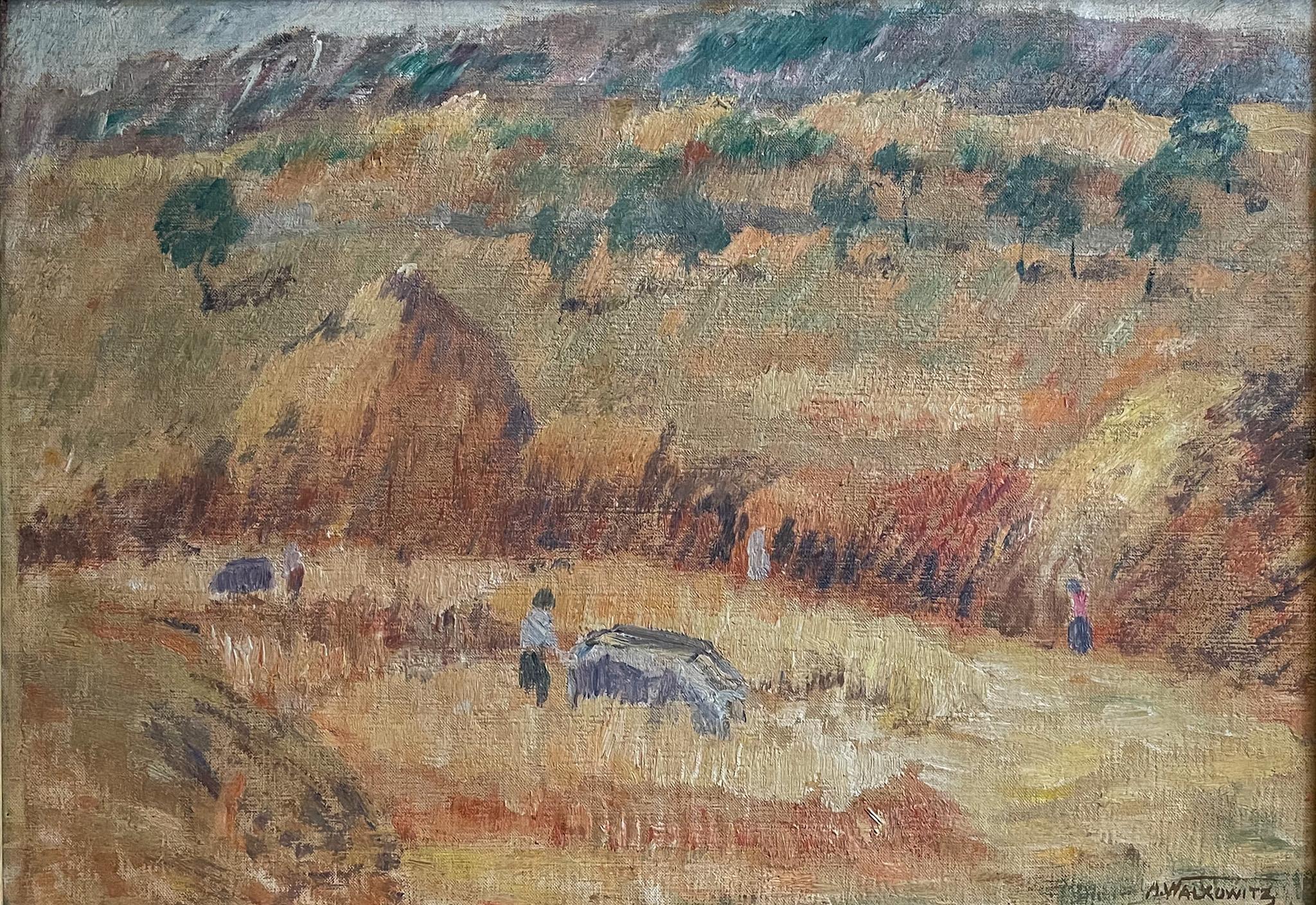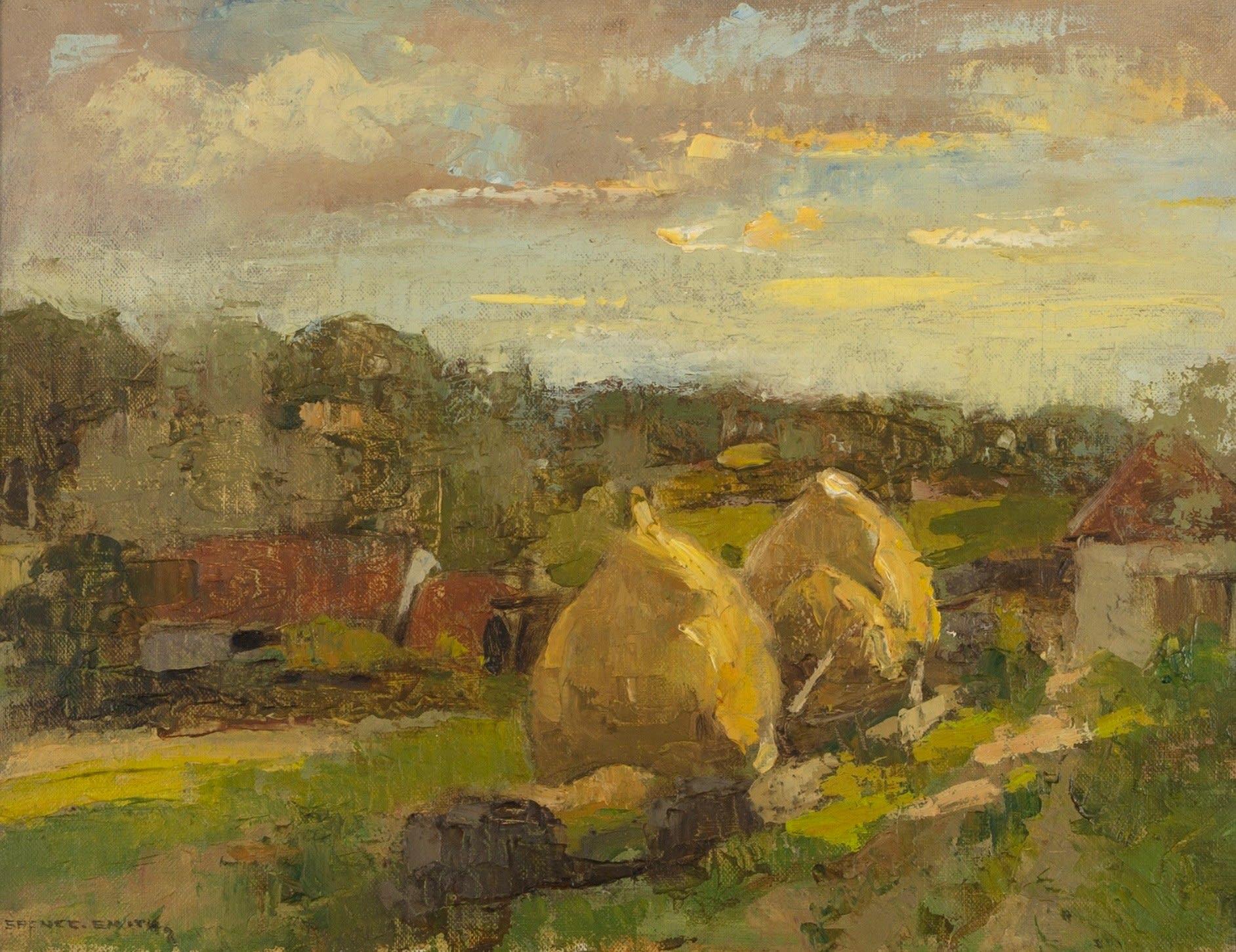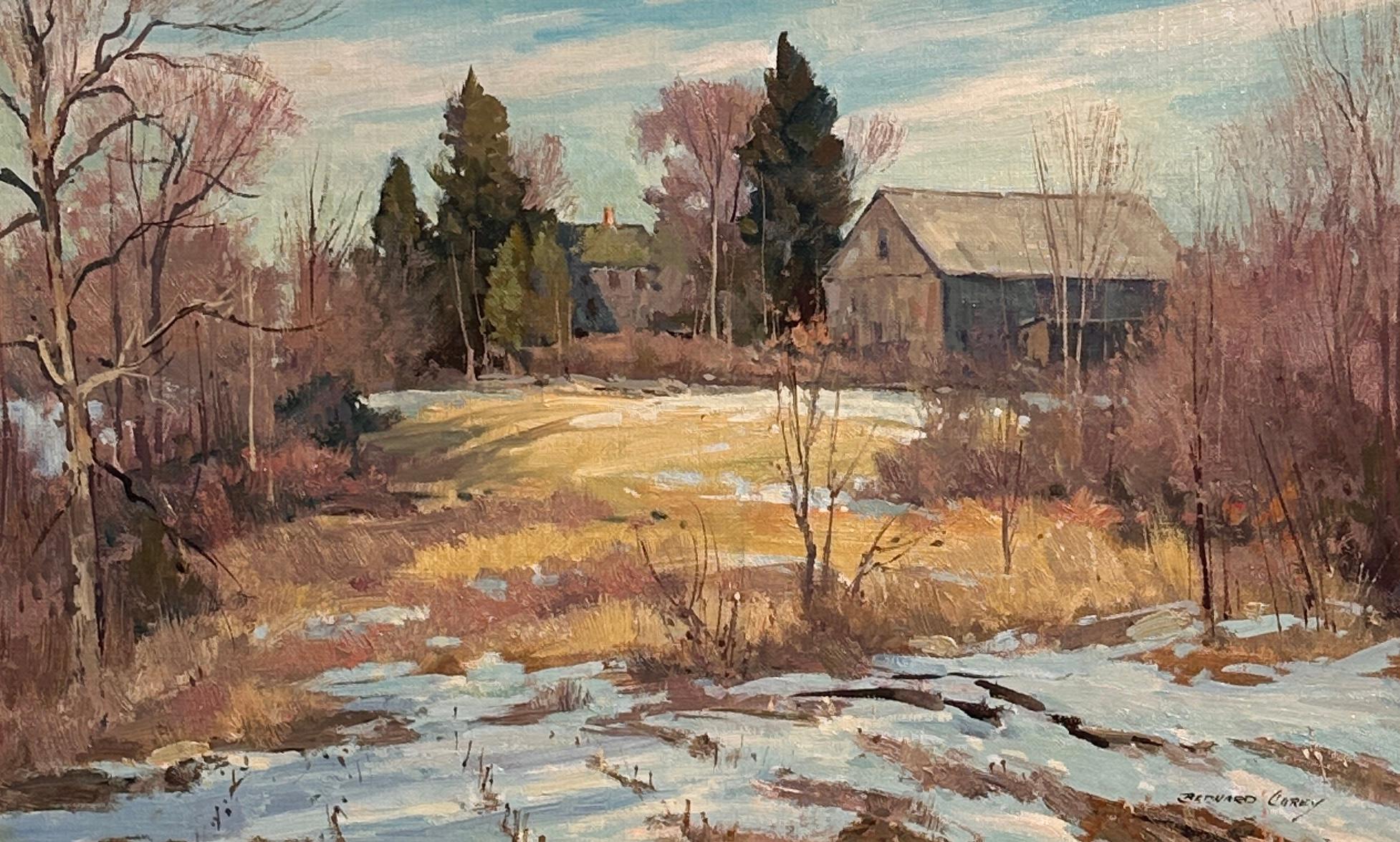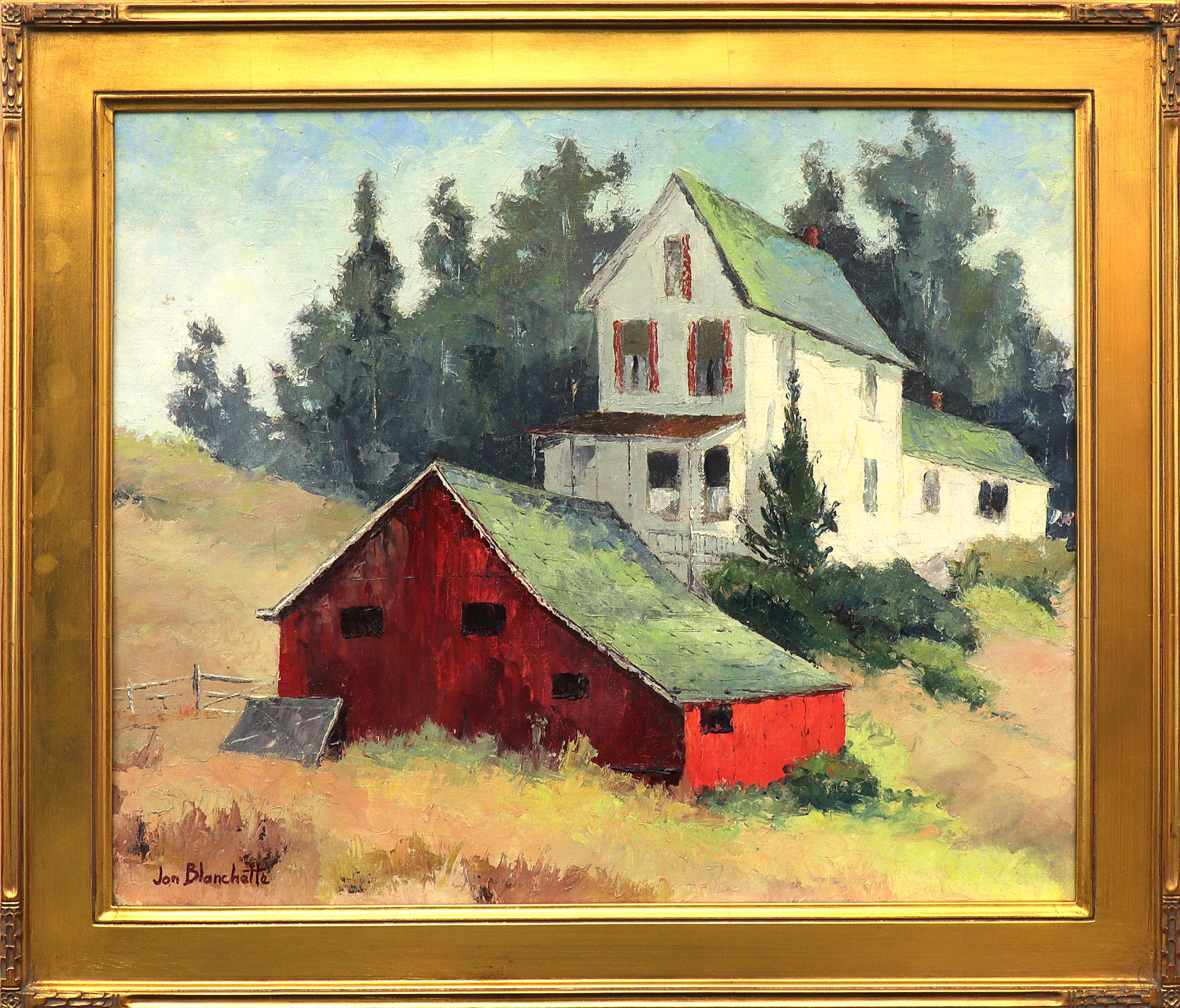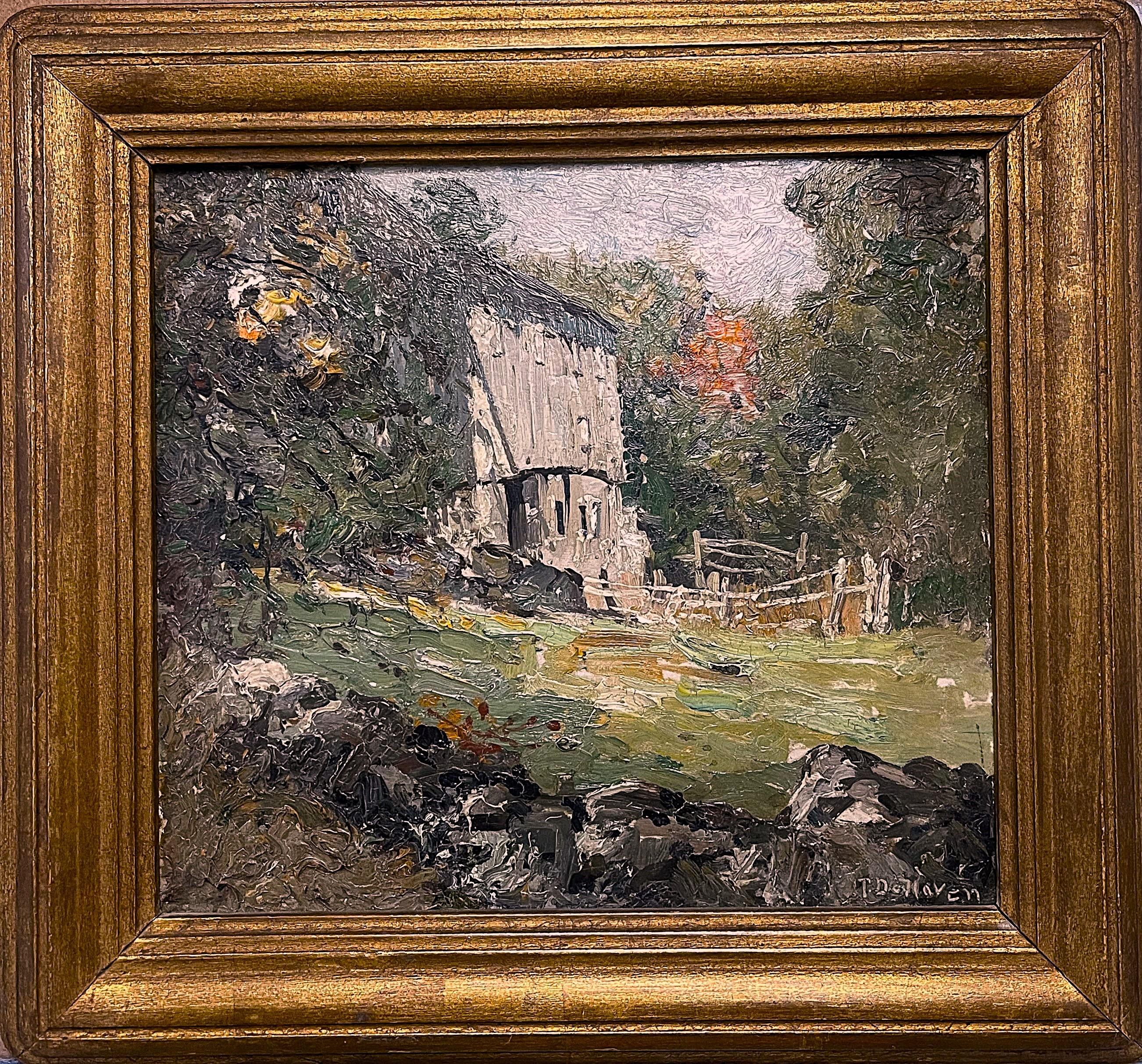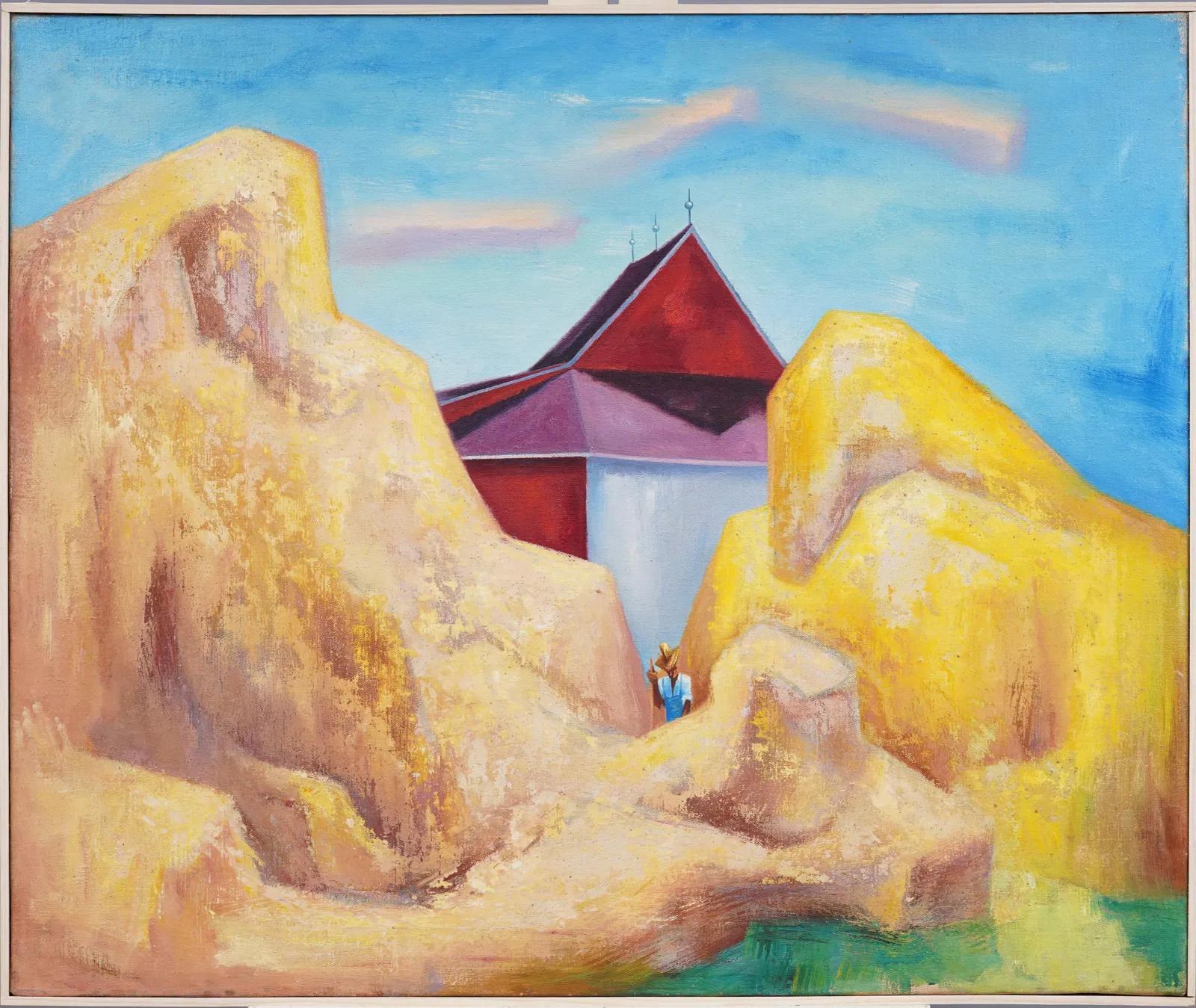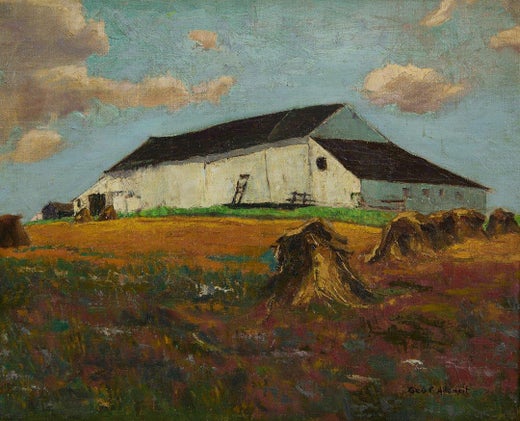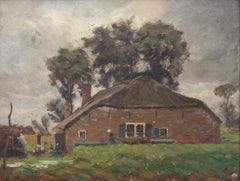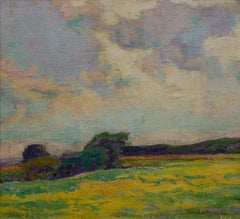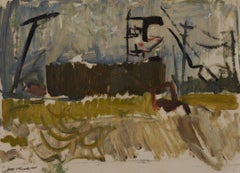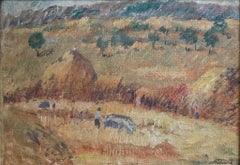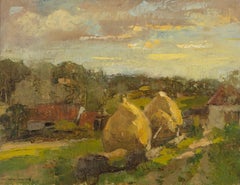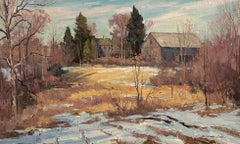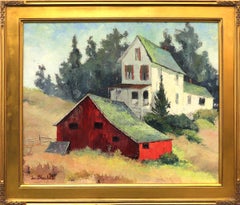Items Similar to 20th Century Landscape of a Barn with Haystacks, Cleveland School Artist
Video Loading
Want more images or videos?
Request additional images or videos from the seller
1 of 21
George Adomeit20th Century Landscape of a Barn with Haystacks, Cleveland School Artist
$4,500
£3,435.73
€3,969.96
CA$6,317.15
A$7,041.12
CHF 3,694.23
MX$85,983.55
NOK 46,777.03
SEK 44,211.41
DKK 29,629.51
About the Item
George Gustav Adomeit (American, 1879-1964)
Barn Scene
Oil on canvas mounted to masonite
Signed lower right
16 x 20 inches
21.5 x 25.5 inches, framed
A major painter of American scene subjects, George Adomeit was born in Memel, Germany, and came to Cleveland at the age of four with his family. Encouraged by his family, he set up a drawing studio in his home at the age of eight. Adomeit took art lessons throughout his high school years and, after winning a full scholarship to the Cleveland School of Art, chose instead a three-year apprenticeship in lithography. He was the cofounder of the Caxton Company, an engraving and commercial art firm that gained national acclaim.
Adomeit's talent for drawing led him to formal training at the Cleveland School of Art, where he graduated in 1911. His first exhibition was of work done outdoors in Zoar, Ohio, a popular plein air painting locale for artists interested in rural subject matter. His imagery was inspired by many other locations, including the Cleveland area and vacation spots such as Cape Cod, Monhegan Island off the coast of Maine, and sites in Mexico, Canada and Brazil.
Adomeit gained a national reputation by showing in exhibitions at the Pennsylvania Academy of Fine Arts, the Toledo Museum of Art, the Corcoran Gallery of Art, and many museums in the East and Midwest. After his retirement from the Caxton Company in 1956, Adomeit continued to travel, paint and exhibit.
- Creator:George Adomeit (1879 - 1967, American)
- Dimensions:Height: 16 in (40.64 cm)Width: 20 in (50.8 cm)
- Medium:
- Movement & Style:
- Period:
- Condition:
- Gallery Location:Beachwood, OH
- Reference Number:1stDibs: LU1768215508682
George Adomeit
A major painter of American scene subjects, George Adomeit was born in Memel, Germany, and came to Cleveland at the age of four with his family. Encouraged by his family, he set up a drawing studio in his home at the age of eight. Adomeit took art lessons throughout his high school years and, after winning a full scholarship to the Cleveland School of Art, chose instead a three-year apprenticeship in lithography. He was the cofounder of the Caxton Company, an engraving and commercial art firm that gained national acclaim. Adomeit's talent for drawing led him to formal training at the Cleveland School of Art, where he graduated in 1911. His first exhibition was of work done outdoors in Zoar, Ohio, a popular plein air painting locale for artists interested in rural subject matter. His imagery was inspired by many other locations, including the Cleveland area and vacation spots such as Cape Cod, Monhegan Island off the coast of Maine, and sites in Mexico, Canada and Brazil. Adomeit gained a national reputation by showing in exhibitions at the Pennsylvania Academy of Fine Arts, the Toledo Museum of Art, the Corcoran Gallery of Art, and many museums in the East and Midwest. After his retirement from the Caxton Company in 1956, Adomeit continued to travel, paint and exhibit.
About the Seller
5.0
Vetted Professional Seller
Every seller passes strict standards for authenticity and reliability
Established in 1975
1stDibs seller since 2022
34 sales on 1stDibs
Typical response time: 1 hour
- ShippingRetrieving quote...Shipping from: Beachwood, OH
- Return Policy
Authenticity Guarantee
In the unlikely event there’s an issue with an item’s authenticity, contact us within 1 year for a full refund. DetailsMoney-Back Guarantee
If your item is not as described, is damaged in transit, or does not arrive, contact us within 7 days for a full refund. Details24-Hour Cancellation
You have a 24-hour grace period in which to reconsider your purchase, with no questions asked.Vetted Professional Sellers
Our world-class sellers must adhere to strict standards for service and quality, maintaining the integrity of our listings.Price-Match Guarantee
If you find that a seller listed the same item for a lower price elsewhere, we’ll match it.Trusted Global Delivery
Our best-in-class carrier network provides specialized shipping options worldwide, including custom delivery.More From This Seller
View AllLandscape Scene with Barn and Trees, Late 19th Century, Ohio Artist
By Addison Thomas Millar
Located in Beachwood, OH
Addison Thomas Millar (American, 1860-1913)
Barn scene, 1892
Oil on board
Signed and dated lower left
10.25 x 13.5 inches
15 x 18.5 inches, framed
Addison Thomas Millar was an American painter and artist; best known for his genre scenes and Orientalist paintings.
He was born to William H. Millar and Permelia Kennedy Millar. His father had emigrated to the United States from Scotland in 1845. He grew up in Warren, Ohio. During his primary education, he took some painting lessons from John Bell, a local landscape painter.
In his late teens, he won three consecutive awards from The Youth's Companion, in their annual art contests. This prompted his parents to allow him to go to Cincinnati to take formal lessons from the genre painter, De Scott Evans...
Category
1890s Landscape Paintings
Materials
Oil
Early 20th Century Summer Landscape, Cleveland School Artist
By George Adomeit
Located in Beachwood, OH
George Gustav Adomeit (American, 1879-1967)
Summer Landscape
Oil on canvas board
Signed lower right
13 x 14.25 inches
18.25 x 19.5 inches, framed
A major painter of American scene s...
Category
Early 20th Century American Modern Figurative Paintings
Materials
Oil
Early 20th Century Landscape with Covered Bridge, Female Cleveland School Artist
By May Ames
Located in Beachwood, OH
May Lydia Ames (American, 1863-1943)
Landscape with Covered Bridge
Oil on canvas
Signed lower left
9.75 x 8 inches
14.5 x 13 inches, framed
May Ames was born in Cleveland in 1863 an...
Category
Early 20th Century American Impressionist Figurative Paintings
Materials
Oil
20th Century Industrial Cityscape Oil painting, Cleveland School Artist
By Joseph O'Sickey
Located in Beachwood, OH
Work sold to benefit the CLEVELAND INSTITUTE OF ART
Joseph B. O’Sickey (American, 1918–2013)
Industrial Cityscape
Oil on paper
Signed lower left
13.75 x 16.5 inches
Joseph O'Sicke...
Category
Late 20th Century Post-Impressionist Landscape Paintings
Materials
Oil
Plowman, Brecksville, Ohio, Early 20th Century Farm Landscape, Cleveland School
By Frank Wilcox
Located in Beachwood, OH
Frank Nelson Wilcox (American, 1887–1964)
Plowman, Brecksville, Ohio, c. 1922
Watercolor on paper
Signed lower right
22.5 x 27.75 inches
27.75 x 34.5 inches, framed
Frank Nelson Wilcox (October 3, 1887 – April 17, 1964) was a modernist American artist and a master of watercolor. Wilcox is described as the "Dean of Cleveland School painters," though some sources give this appellation to Henry Keller or Frederick Gottwald. Wilcox was born on October 3, 1887 to Frank Nelson Wilcox, Sr. and Jessie Fremont Snow Wilcox at 61 Linwood Street in Cleveland, Ohio. His father, a prominent lawyer, died at home in 1904 shortly before Wilcox' 17th birthday. His brother, lawyer and publisher Owen N. Wilcox, was president of the Gates Legal Publishing Company or The Gates Press. His sister Ruth Wilcox was a respected librarian.
In 1906 Wilcox enrolled from the Cleveland School of Art under the tutelage of Henry Keller, Louis Rorimer, and Frederick Gottwald. He also attended Keller's Berlin Heights summer school from 1909. After graduating in 1910, Wilcox traveled and studied in Europe, sometimes dropping by Académie Colarossi in the evening to sketch the model or the other students at their easels, where he was influenced by French impressionism. Wilcox was influenced by Keller's innovative watercolor techniques, and from 1910 to 1916 they experimented together with impressionism and post-impressionism. Wilcox soon developed his own signature style in the American Scene or Regionalist tradition of the early 20th century. He joined the Cleveland School of Art faculty in 1913. Among his students were Lawrence Edwin Blazey, Carl Gaertner, Paul Travis, and Charles E. Burchfield. Around this time Wilcox became associated with Cowan Pottery.
In 1916 Wilcox married fellow artist Florence Bard, and they spent most of their honeymoon painting in Berlin Heights with Keller. They had one daughter, Mary. In 1918 he joined the Cleveland Society of Artists, a conservative counter to the Bohemian Kokoon Arts Club, and would later serve as its president. He also began teaching night school at the John Huntington Polytechnic Institute at this time, and taught briefly at Baldwin-Wallace College.
Wilcox wrote and illustrated Ohio Indian Trails in 1933, which was favorably reviewed by the New York Times in 1934. This book was edited and reprinted in 1970 by William A. McGill. McGill also edited and reprinted Wilcox' Canals of the Old Northwest in 1969. Wilcox also wrote, illustrated, and published Weather Wisdom in 1949, a limited edition (50 copies) of twenty-four serigraphs (silk screen prints) accompanied by commentary "based upon familiar weather observations commonly made by people living in the country."
Wilcox displayed over 250 works at Cleveland's annual May Show. He received numerous awards, including the Penton Medal for The Omnibus, Paris (1920), Fish Tug on Lake Erie (1921), Blacksmith Shop (1922), and The Gravel Pit (1922). Other paintings include The Trailing Fog (1929), Under the Big Top (1930), and Ohio Landscape...
Category
1920s American Modern Figurative Drawings and Watercolors
Materials
Watercolor
Mid Century Modernist Watercolor Landscape with Horse, Cleveland School
By William Sommer
Located in Beachwood, OH
William Sommer (American, 1867–1949)
Spring Beauty
Watercolor on paper
Signed lower right
12.5 x 17 inches
18 x 22.75 inches, framed
William Sommer is seen as a key person in bringi...
Category
Mid-20th Century American Modern Figurative Paintings
Materials
Watercolor
You May Also Like
Haystacks
By Abraham Walkowitz
Located in New York, NY
Haystacks by Abraham Walkowitz (1878-1965)
Oil on canvas
14 x 20 inches unframed (35.56 x 50.8 cm)
19 ½ x 25 ½ inches framed (49.53 x 64.77 cm)
Signed on lower right
Description:
Ab...
Category
20th Century American Impressionist Landscape Paintings
Materials
Oil
Price Upon Request
Haystacks, Oil on Canvas Board by John Guthrie Spence Smith
Located in Kingsclere, GB
Haystacks, Oil on Canvas Board by John Guthrie Spence Smith
Additional information:
Medium: Oil on Canvas Board
32 x 42 cm
12 5/8 x 16 1/2 in
Signed
Category
20th Century Landscape Drawings and Watercolors
Materials
Canvas
Massachusetts Landscape Painter Bernard Corey
By Bernard Corey
Located in Rockport, MA
"Quiet Fields of Winter" by Bernard Corey is a beautiful landscape that showcases his exceptional talent for depicting tranquil, rural scenes throughout New England, particularly in ...
Category
20th Century American Impressionist Landscape Paintings
Materials
Oil
1950s Farm Landscape Oil Painting, Barn & House Near Cabrillo, California
By Jon Blanchette
Located in Denver, CO
This mid-20th century oil painting depicts a serene farm landscape near Cabrillo, California, painted by renowned artist Jon Blanchette circa 1955. The scene features a vibrant red b...
Category
1950s American Impressionist Landscape Paintings
Materials
Oil
Franklin Dehaven, NA Oil Painting Salmagundi Artist Farm with Barn Sunny Day
By Franklin DeHaven
Located in Chesterfield, NJ
Sunny Afternoon, farm with barn
oil on panel. Image is 10 x 9 unframed and 13 3/4 x 12 3/4 x 1 framed.
Salmagundi Club label and bio verso plus 2 other labels as seen. One partial...
Category
Early 20th Century Impressionist Landscape Paintings
Materials
Oil
Antique American School Modernist Hay Barn Regionalist Farmer Oil Painting
Located in Buffalo, NY
Impressive early American modernist farm landscape painting. Framed. Oil on canvas. Image size, 25H by 30L.
Category
1940s Modern Abstract Paintings
Materials
Canvas, Oil
$1,180 Sale Price
20% Off
More Ways To Browse
Canadian Art 20th Century
Brazilian Antique Art
Antique Barn
Haystacks Painting
Plein Air Mexico
Antique Barn Frames
Canadian Landscape Artists Early 20th Century
Maine Coast Oil Painting
Maine Plein Air Paintings
Haystack Oil Painting
Haystacks Oil
Monhegan Paintings
Monhegan Island
Monhegan Island Painting
Vintage Circus Horse
Tango Dancers
Horses Atelier
Giovanni S Paintings
